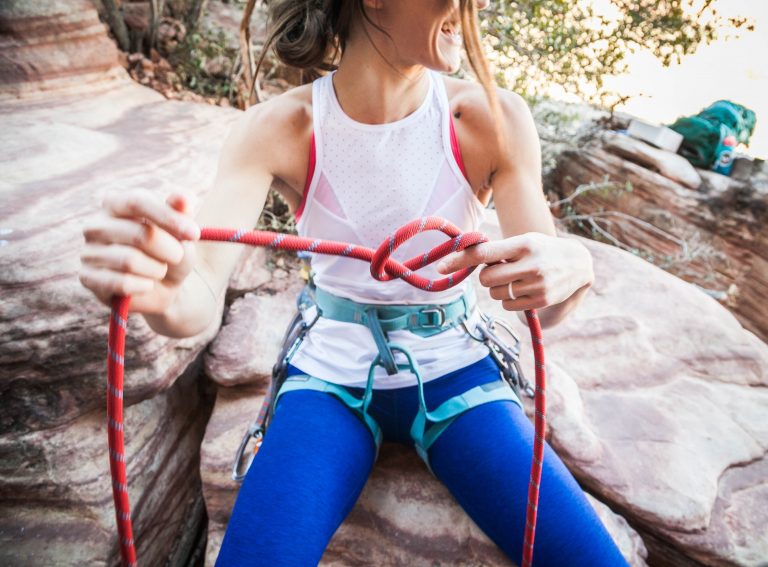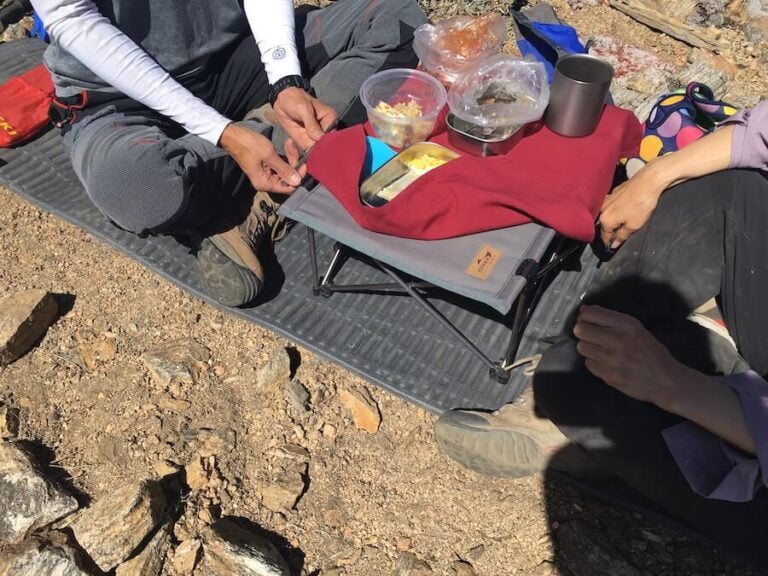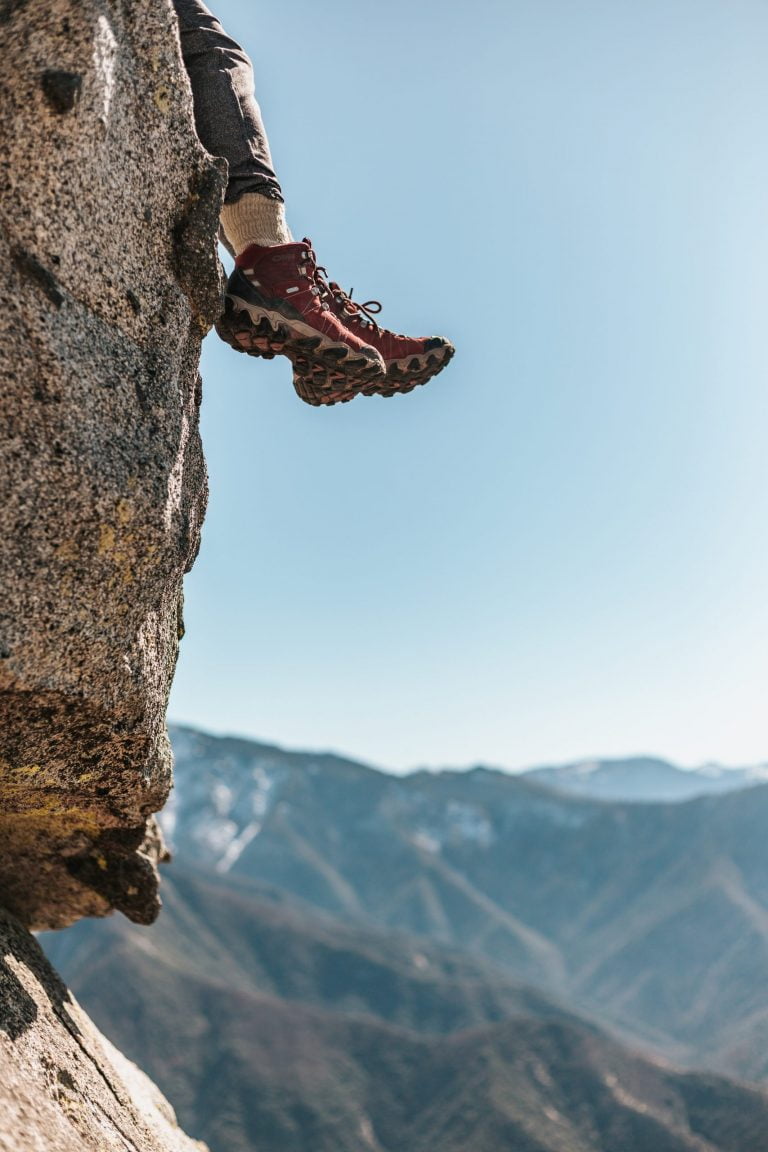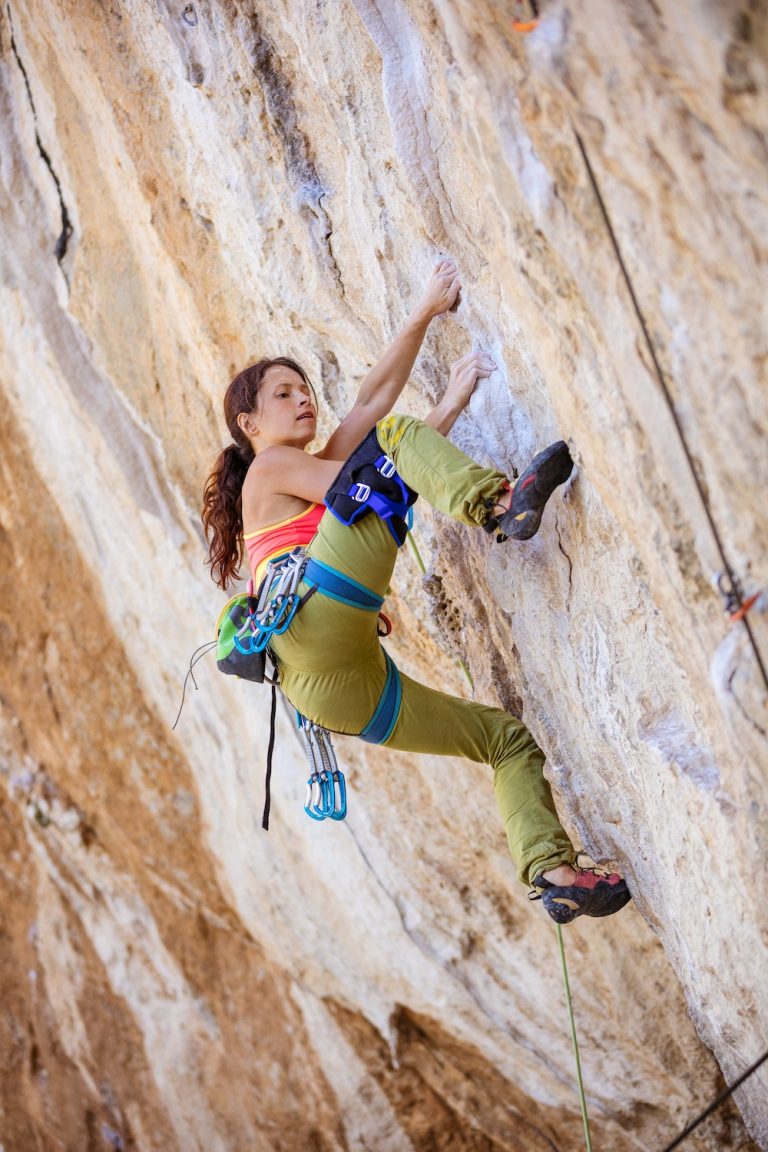How Should You Pack a Wet Tent?
In preparation for this piece, I asked my friendly neighborhood thru-hiker their thoughts on the above question. The answer: “Don’t. Get a hammock.”
As helpful as that advice is, the reality is that many backpackers (and thru hikers!) choose tents over hammocks for their treks for a variety of reasons. And while rain isn’t a sure concern on every trail, it is an inevitability of backpacking. Sooner or later, you’ll be riding out a thunderstorm in your tent, crossing your fingers that the water doesn’t enter the tent and soak you and your sleeping bag, too.
If you’re lucky, that overnight thunderstorm will pass, and you’ll wake up to clear blue skies and a bright, sunshiney day. In this case, you’ll simply lay your tent and rain fly over a rock or a stout shrubbery, and let that thermal solar goodness do all the work. However, luck isn’t always with us. Sometimes you’re packing up and setting out in that same storm the next morning.
Many folks now hike with some sort of satellite device capable of pulling weather updates, and even if you choose to adventure without one, it is unwise to go into the backcountry without doing a preliminary weather check. If storm clouds are in your near future, do your best to be prepared.
To help minimize frustration and get you back on trail sooner and drier, below are some tips and advice on how to prevent and more effectively alleviate tent wetness when backpacking.
Before the Rain
Location, Location, Location
- This should go without saying, but if you’re expecting serious rain, perhaps don’t pitch your tent at the bottom of a slope or within close proximity to a stream or runoff area.
- Choose an area that has some natural shelter, like tree cover or overhanging rocks if possible.
- If it is not insanely windy or leaving you too exposed, choose a spot at a slightly higher rise or elevation than other areas nearby. Water runs downward, so if you are physically higher, you’ll be on the favorable end of gravity, and less likely to encounter heavy groundwater.
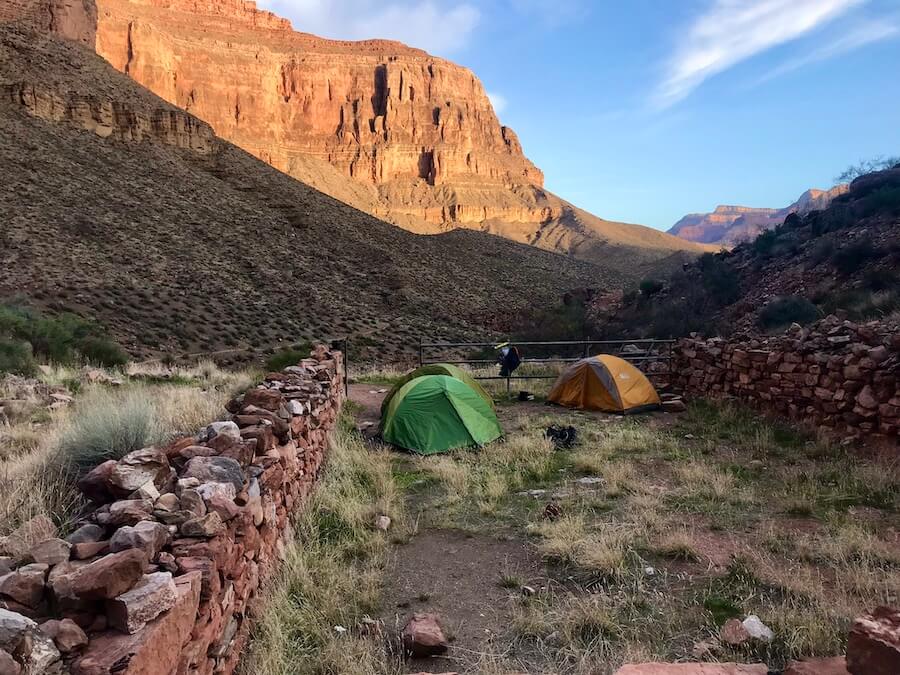
DO Sweat the Small Stuff.
- By this, we mean paying attention to details when pitching your tent. Stake your tent, fly, and guylines properly to direct runoff away from the tent.
- Check your zippers and vents. If it’s expected to rain sideways, you can use all the protection you can get.
- Ensure your tent footprint is the correct size for your tent. If you’ve ever been camping and seen tarps or ground cloths sticking out from underneath a tent, you have been seeing the wrong way to do it.
Think of it as a coffee mug and saucer situation; the saucer is intended to catch drips and overflow, keeping that liquid off of the table’s surface. If your ground cloth extends past the perimeter of your tent, it is essentially directing the water to pool underneath your tent, between the ground cloth and the tent floor, where it will be unable to drain away.
Your ground cloth should be 2-3” smaller than your tent’s footprint, and most manufacturers offer a ground cloth companion for any tent in their stock. If you’d rather go a DIY route with a basic tarp, pick up a grommet kit and be sure to size it correctly to the spoecifics of your tent.
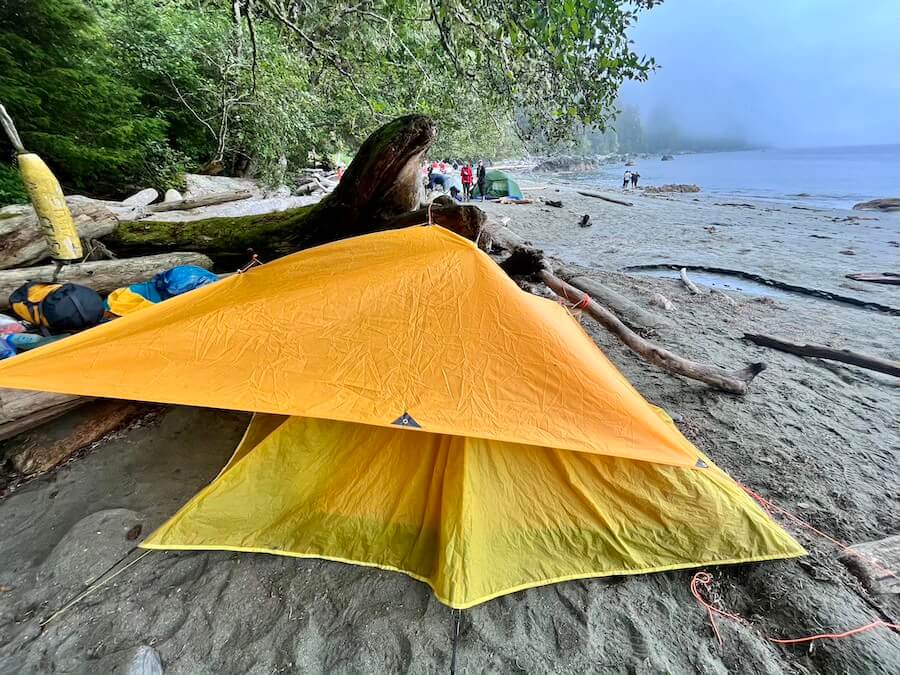
- Pay attention to where moisture is coming from, and if you know you have a weak area or small tear in your tent, repair it ASAP, before your next storm.
- Pro tip from that same friendly thru hiker: If you really want to stay dry inside your tent forget the foot print completely. Cut a tarp (or even better, a piece of tyvek) to size and lay it down inside your tent. This removes the possibility of water ever having the opportunity to pool up between the footprint and your tent and soaking you from the bottom up. Your tent’s fly will keep the ground below you dry and without a waterproof material there to collect moisture beneath your tent any runoff will simply be absorbed by the ground. This is the only foolproof way to guarantee water will not come in your tent through the floor, which is what causes the vast majority of wet sleeping bags and uncomfortable nights of cold wet sleep. Your tent floor will also dry out much faster if it is not sitting on top of a wet ground tarp all night long in the unlikely scenario that water does find a way to drain under your footprint free tent.
Packing up a Wet Tent
When your tent gets wet, there are some tried-and-true strategies to make the most of it, and to speed up drying times.
- Take advantage of solar power. As mentioned above, if the sun is up when you wake, take your fly off right away and spread it in the sun. If there are no shrubberies or rocks available, spread it out wide on a patch of grass, and when that side is dry, flip it over onto a different patch of grass. With any luck, the surrounding area dried up a little while your fly was also drying, and the grass won’t re-wet your newly dry fly side.
Leave your tent intact for a few more minutes, if possible, while you make coffee and prepare for the day. Your tent body’s mesh walls will dry quicker with air moving through them, and the sun will quickly evaporate any remaining condensation.
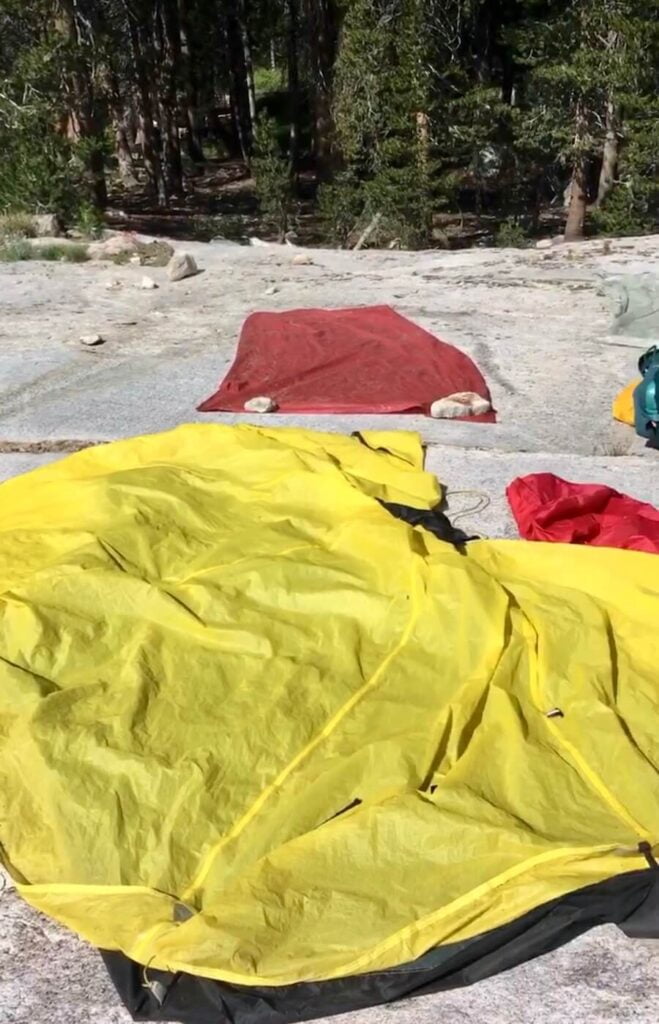
- Use a pack towel. A lightweight, quick-dry pack towel is a lifesaver. If the sun isn’t working fast enough, use your towel (not a sock or a t-shirt) to swipe off the last few droplets. Your towel is designed to absorb water and then dry quickly if you hang it outside your pack, and using this approach sure beats hanging your tent off your pack instead! (That’s a joke, please don’t wear your tent as a cape.)
- Bring a trash bag or watertight roll-top bag. If you do have to pack your tent away wet, at least keep it fully separate from the dry stuff. Some folks also use a ziploc gallon bag for this purpose. Roll up tight to compress your tent, and make sure that any opening in the bag is facing up, not down, so that it doesn’t accidentally drain into your dry stuff.
- Dry-as-you-go. If the weather isn’t favorable when you break camp, keep your fly on the outside of your pack and wait until the weather clears up a bit later on. If it means you do fewer miles that day, it may be worth it to ensure your shelter is dry and tended to, especially if your sleeping bag or pad are also wet. Spread your tent and fly out on your lunch break, water break, or even let the weather dictate the break- if the sun is looking good now but clouds are expected for the rest of the day, just enjoy the respite and tend to your gear.
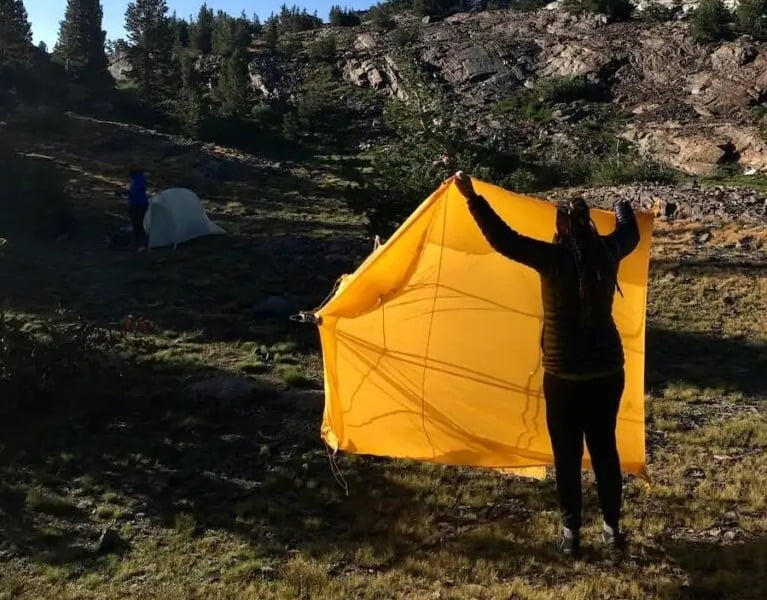
- Be strategic with your breakdown. If it’s still misting or damp out when you begin to break down your camp, do as much as you can under the rain fly and poles first. Most backpacking tents can be separated from the pole and fly structure, so you should be able to pack up your pad, sleeping bag, and pack under cover first. When that stuff is tucked away into a more-dry section of your pack, then you can break down the fly and poles, and you thus have fewer wet things to fuss with.
Reminders
- Even if you’re unable to dry out your tent that same day, do prioritize it. Backpacking tents are sturdy and designed for frequent use, but leaving them bunched up and wet can result in unsavory mold and mildew buildup or damage to the material.
- This may seem like common sense, but don’t throw your tent in the washing machine. If mold or mildew does occur, reach out to the manufacturer for cleaning advice before just using whatever is handy- your household cleaner of choice might contain an element that could degrade your tent’s material or weatherproofing, even if it’s marketed as eco-friendly. Eco-friendly and tent friendly are not necessarily the same thing!
- Don’t underestimate the power of a good wrist flick. If time is of the essence, grab a friend and shake your fly out a few times like you’re a child with a parachute. That will get off a lot of the droplets, and hey, it’s also fun.

By taking the time to set your tent up up properly, being thoughtful and selectively choosing naturally protected and unexposed campsites, your rainfly should really be the only piece of wet gear you ever need to deal with.
Dare To Be A Wildflower is a participant in the Amazon Services LLC Associates Program, an affiliate advertising program designed to provide a means for sites to earn advertising fees by advertising and linking to amazon.com.

